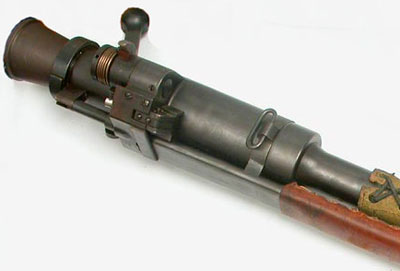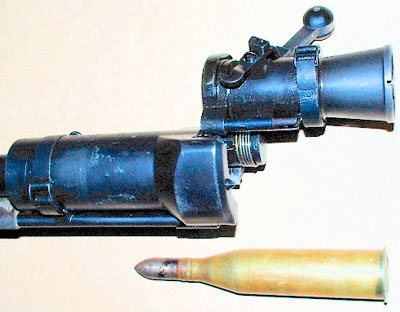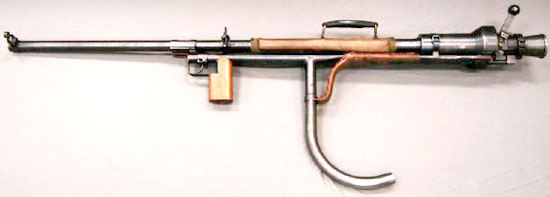Anti-tank rifle Carl Gustav pvg m/42


Carl Gustav pvg m/42
In 1940, the designers of the Carl Gustav company, as part of the program for the development of infantry anti-tank weapons of close combat, began work on the creation of a large-caliber anti-tank rifle (ATR). In order to reduce weight and recoil, Swedish engineers used the dynamo-reactive principle in this weapon.
A new 20 mm ammunition (20x180R) was developed specifically for this weapon. The large size of the cartridge was a consequence of the fact that it was necessary to compensate for the breakthrough of gases through the nozzle with the large weight of the powder charge.

Carl Gustav PVG m/42
with ammunition in use
In 1942, after a series of tests, the Swedish army adopted a large-caliber anti-tank rifle, which received the official designation “pvg m/42” (Pansarvärnsgevär m/42 - anti-tank rifle model 42).

View of the breech Carl Gustav PVG m/42
The Carl Gustav pvg m/42 anti-tank missile is a single-shot dynamo-jet weapon with a rifled barrel.
The barrel in the rear is open and equipped with a folding breech with an exhaust nozzle.
For loading, the breech with the nozzle is tilted around the longitudinal axis up and to the right. If the breech is not completely closed, the shot is impossible.
A pistol grip, a mechanical trigger mechanism with a manual safety, a shoulder rest and a removable one-legged support bipod are fixed under the barrel.
To carry the gun, a handle is installed in the center of gravity of the weapon.
The gun has open sights on folding bases, located on the left side of the barrel. The sight is calibrated for a range of up to 300 meters.
For firing from the Carl Gustav pvg m/42 anti-tank rifle, 20-mm ammunition was used, completed in the form of a unitary cartridge and consisting of an armor-piercing projectile with a carbide core and a massive case. The case in the rear part has a knockout bottom, which first provides the necessary forcing pressure when firing, and then the flow of powder gases from the barrel backwards, through the nozzle, to ensure recoilless firing by creating a reactive effect.

view of an open breech Carl Gustav pvg m/42
and a 20x180R cartridge
Different types of shells were used in the weapon. Armor-piercing and armor-piercing tracer shells were used to combat armored targets. With a projectile weight of 130-150 g, its muzzle velocity was 800-820 m/s, and with a projectile weight of 108 g, the muzzle velocity was about 950 m/s.
Adopted by the Swedish Army in 1942, the Carl Gustav pvg m/42 anti-tank rifle was the first anti-tank weapon adopted on the dynamo-jet (recoilless) principle.
Thanks to the use of a single-shot dynamo-jet scheme, this gun became the lightest in its class - it weighed 4-5 times lighter than other anti-tank rifles of the same caliber with comparable, if not greater, armor penetration. At the same time, the recoil of the weapon was not high. Unlike most other anti-tank rifles, this model was designed to fire “from the shoulder”, although, if necessary, firing with an emphasis on the ground was also allowed.
| Caliber, mm | 20x180R |
|---|---|
| Length, mm | 1450 |
| Barrel length, mm | 1114 |
| Weight without cartridges, kg | 11.0 |
| Sighting range, m | 300 |
| Muzzle velocity, m/s | 820 (950) |
| Armor penetration, | |
| (distance / angle of encounter / penetration) | 100 m / 90o / 40 mm |
The price for such relatively high results was the significant dimensions and high cost of shells specially created for it. At the same time, by the standards of 1942-1943, the armor penetration of 40 mm was already considered insufficient.
Despite this, the military placed an order for 3219 such guns. Deliveries were planned between August 1942 and July 1944. But in total, by the end of World War II, about 1000 units of these weapons were produced, and the first 500 turned out to be defective and were used only for training until the defects were eliminated.
The main value of the Carl Gustav pvg m/42 anti-tank missile system can be considered the acquisition by Swedish gunsmiths of the appropriate experience and skills to create by 1948 on its basis one of the most successful post-war models of anti-tank weapons - the 84-mm dynamo-rocket anti-tank grenade launcher “Calr Gustav”.


Carl Gustav pvg m/42